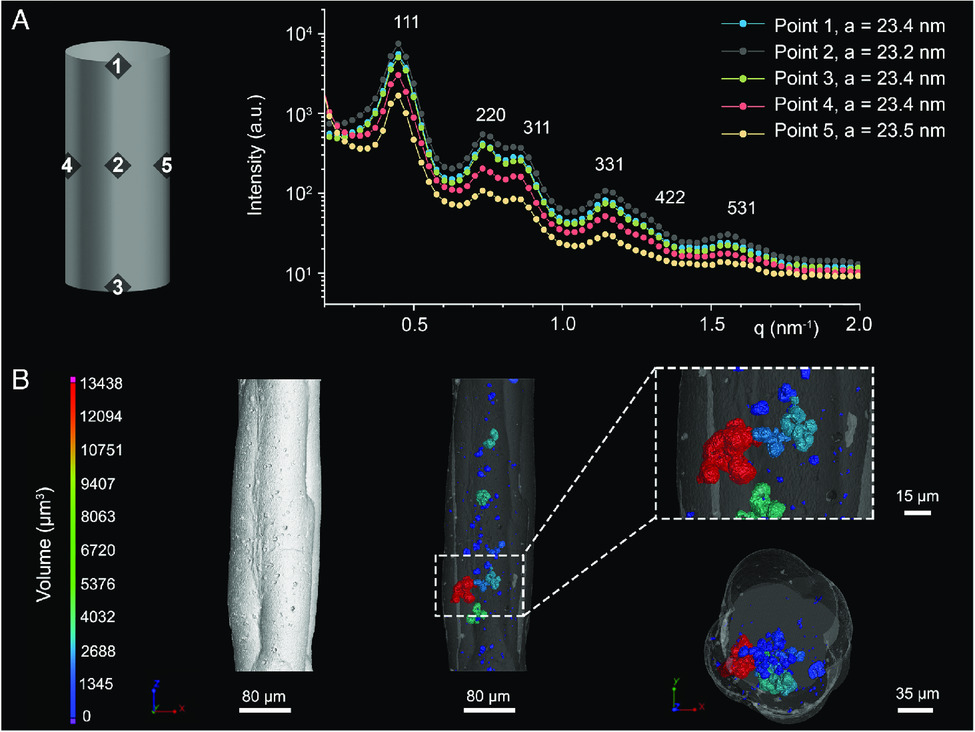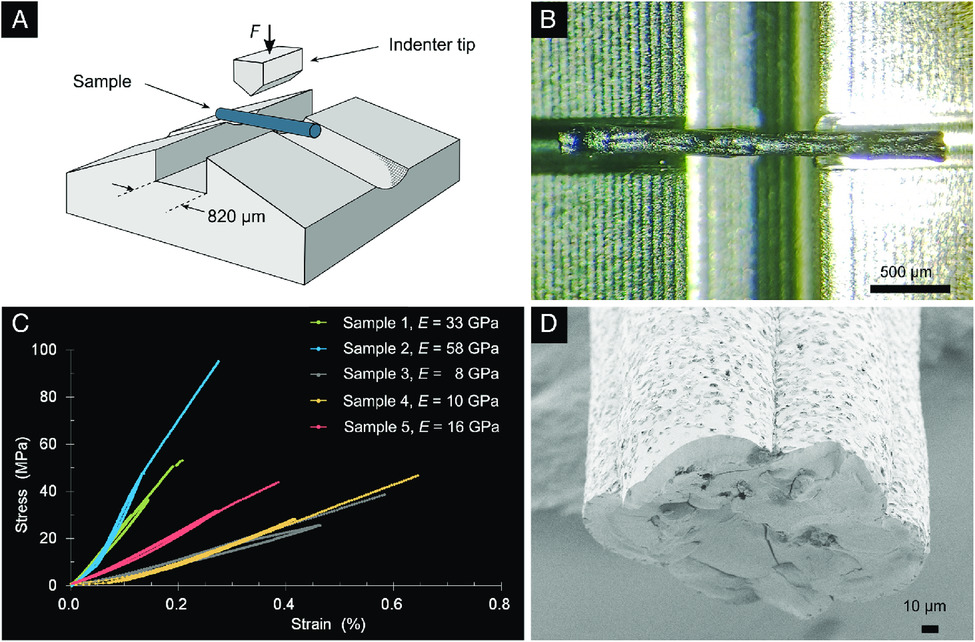Researchers from the Technical University of Hamburg (TUHH) and the Massachusetts Institute of Technology (MIT), in collaboration with the and Bremen University, have used 3D printing to assemble nanoparticles into strong macrostructures.
The research team developed a direct-write self-assembly technique, which was summarily reinforced with cross-linking, that allowed for the structural strength of microstructures to be reflected in their macro counterparts. Combining 3D printing with this colloidal assembly method, could lead to the development of mechanically robust, multifunctional 3D structures, and open new applications for the resulting materials in the aerospace industry.
“3D printing offers a fast and controllable way to develop new materials. Previously 3D printed particle-based materials were generally weak since their particles were held together mainly by weak forces. In our case, the crosslinking step serves as a reinforcement mechanism. This creates a tightly packed network of strong, covalently bonded nanoparticles throughout the material,” says Dr. Berta Domènech from TUHH, who coordinated the study.

Harnessing the strength of microscale structures
Macroscopic structures normally contain numerous cracks or defects, which could cause them to fail when placed under higher loads. Nanoscopic materials on the other hand, are virtually defect-free, so the potential to incorporate the benefits of microstructures into their macro-equivalents, could provide the latter with upgraded strength. In order to achieve this integration, a manufacturing method needed to be developed that enabled precise control over the composition and assembly of nanoparticles (NP).
The researchers proposed that NPs could be assembled into larger structures, by exploiting and further controlling their inherent intermolecular and surface forces. Using these short-range forces made colloidal self-assembly a viable approach, allowing for the nanoblocks to be specifically designed, and the resulting materials’ behavior to be tuned. While colloidal self-assembly is typically used to create 1D or 2D structures, utilizing 3D printing allowed for the tailor-made design of 3D material systems, across multiple-length scales.
In order to use this direct-ink-writing 3D printing technique effectively, the research team would need to use a shear thinning ink that flowed through the needle aperture under stress, and had shape retention capability upon deposition. As a result, the successful bridging of several length scales depended on the intrinsic mechanical robustness of synthesized nanocomposites. Although NPs are ultra-strong up to their theoretical strength, the bonding forces between NPs needed to be in the order of several hundreds of MPa to work, and a new approach was needed from the team. In response, the researchers devised a method combining direct-write 3D printing, with the colloidal self-assembly of iron oxide NPs, to create robust free-standing macroscale structures.

3D printing high-strength macrostructures
The direct-write colloidal assembly was constructed using a custom-fabricated benchtop direct-writing system, that was initially developed at MIT. To create the structures, a toluene-based suspension of OA-functionalized Fe3O4‐NPs was dispensed from a high-precision needle onto a substrate, forming a liquid bridge. During the colloidal assembly, the bridge provides confinement for the NPs that accumulate at the base, and form the self-assembled solid column. The process was controllable, by moving the substrate downward at a rate matched to the vertical growth rate of the self-assembled printed column. Additional strengthening was applied via heat-treatment in an inert atmosphere at 325 ºC, which resulted in the creation of new bonds (or crosslinking) between the organic molecules of adjacent nanoparticles. The resulting organic part was stiffer, and more resistant to higher loads, with a similar solidifying effect to that of the curing process on a common epoxy resin.
Leveraging this new technique, the researchers produced free-standing millimeter-sized columns, with a super crystalline structure. The miniature pillars, consisting of ordered arrangements (supercrystals) of spherical iron oxide nanoparticles, were found to exhibit a surface coated with short organic molecules (oleic acid). This surface-functionalization was found to be responsible for the material’s enhanced mechanical properties. The bonding force allowed for the controlled assembly of the nanoparticles into closely packed ordered arrangements, and the organic molecules acted as active sites for the additional strengthening of the material.
In order to assess possible variations in the superlattices, synchrotron-based Small Angle X-ray Scattering (SAXS) analyses were conducted at different points along the columns’ axes. The scans identified that a superlattice had formed, and detected no significant differences to the lattice parameter as a function of the column position. A summary X‐Ray Microscopy (XRM) was applied to a section of a 3D printed column with a total length of 460 μm. This scan detected asymmetrically distributed internal voids and pores inside the columns of 41 311 μm3, which corresponds to 0.6% of the samples’ evaluated total volume.
The research team had successfully demonstrated that the combination of colloidal-assembly with 3D printing, enables the facile and fast fabrication of robust columns, bridging almost five different length scales. According to the researchers, they will now attempt to gain more control over the parameters of the process, extend the study to other nanoparticle systems, and summarily create 3D printed parts with varying geometries. The new technique could lead to the integration of nanoscale-building blocks into a variety of macroscopic multifunctional materials, ranging from photonic devices to new structural materials.
High durability macrostructures in 3D printing
Researchers from a variety of government departments and academic institutions, have devised new 3D printing methods that create more durable metals in recent years.
Texas A&M University researchers established a set of guidelines and parameters that allow for the additive manufacturing of low-alloys into defect-free parts in March 2020. The team developed a criterion for precisely determining the maximum spacing between hatching lines, allowing them to avoid defects caused by insufficient fusion between layers.
The U.S. Air Force Institute of Technology (AFIT) developed a method of 3D printing the high-performance Air Force steel AF-9628 for weapon applications in September 2019. Innovating a new powder bed fusion (PBF) technique, enabled the production of a metal that exhibited higher tensile strength than conventional AM alloys.
In October 2019, NASA’s Marshall Space Flight Center (MSFC) became the first commercial customer of HRL Laboratories’ 7A77 aluminum 3D printing powder. The material is a developed version of Al-7075, which has good ductility, high strength, toughness, and excellent corrosion resistance, but can be difficult to 3D print with.
The researchers’ findings are detailed in their paper titled “Strong Macroscale Supercrystalline Structures by 3D Printing Combined with Self‐Assembly of Ceramic Functionalized Nanoparticles,” published on April 29th, 2020 in the Advanced Engineering Materials journal. The research was co-authored by Berta Domènech Alvin T. L. Tan, Hans Jelitto, Eduardo Zegarra Berodt, Malte Blankenburg, Oliver Focke, Jaclyn Cann, C. Cem Tasan, Lucio Colombi Ciacchi, Martin Müller, Kaline P. Furlan, A. John Hart and Gerold A. Schneider.
The nominations for the 2020 3D Printing Industry Awards are now open. Who do you think should make the shortlists for this year’s show? Have your say now.
Subscribe to the 3D Printing Industry newsletter for the latest news in additive manufacturing. You can also stay connected by following us on Twitter and liking us on Facebook.
Looking for a career in additive manufacturing? Visit 3D Printing Jobs for a selection of roles in the industry.
Featured image shows the column samples being put through bending tests. Image via Advanced Engineering Materials.


